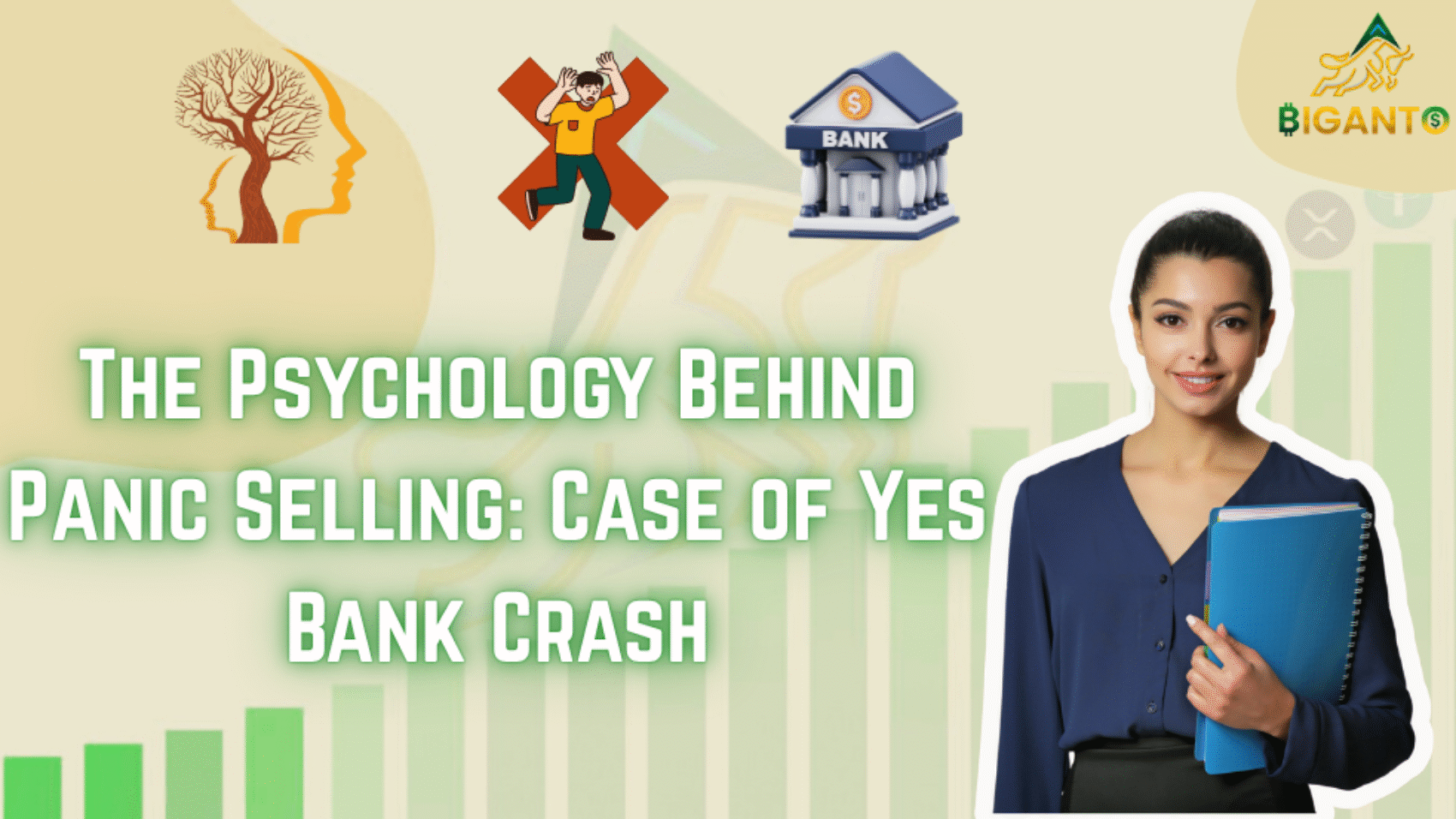Panic selling reflects how investors justify quick exits during market drops, often rushing to sell in an attempt to limit losses. In this Panic Selling Case Study: Yes Bank, we explore how fear-driven decisions unfolded during the bank’s crisis from 2018 to 2020. Triggered by sudden fear of losses, investor sentiment shifted drastically—from rising NPAs and governance failures to RBI intervention—ultimately causing a sharp plunge in the stock.
Introduction: Understanding Panic Selling
Panic selling is a natural response to market volatility, driven by a perceived threat to financial security. Rooted in behavioral finance, panic selling shows how fear of loss often outweighs the desire for gains. While sometimes unavoidable, understanding this behavior helps investors make better decisions about when to sell or hold.
Background: Yes Bank
Banks play a vital role in maintaining economic stability, and Yes Bank’s potential collapse in March 2020 sparked widespread public fear.
News of the crisis alarmed depositors, but the situation was eventually addressed by the Reserve Bank of India.
The causes of the Yes Bank crisis
One of the largest banks in India is Yes Bank. India has banks in both the public and private sectors. Yes, the bank had a difficult time in 2020. The RBI replaced the private sector lender board, placed Yes Bank under a 30-day moratorium, and named Prashant Kumar as its administrator on March 5, 2020.
Depositors were permitted to take out up to $50,000 per person during this moratorium.
Furthermore, protecting depositor funds is the primary goal of the Reserve Bank of India or the Indian government.
The Psychology Behind Panic Selling
FOMO (Fear of Missing Out) In Reverse
While FOMO usually applies to buying in a bull market, in the Yes Bank crash it took on a reverse form—fear of missing out on escaping before the price dropped further.
As the share price plunged from ₹36 to below ₹10 within days, many investors saw others selling in large volumes. The anxiety was that if they didn’t sell now, they might miss the chance to exit at a still-acceptable price before it went to zero.
Parallel to bull-market FOMO:
just as FOMO drives late buying in bull markets (like during the Bitcoin boom), reverse FOMO in a crash triggers panic selling. Each small bounce becomes a chance to exit, pushing prices even lower. In Yes Bank’s case, despite RBI’s restructuring hints, brief price recoveries were quickly sold off by investors desperate to avoid deeper losses. This intensified the volatility and prolonged the sell-off phase.
The Behavior of Herds
People have a tendency to follow the herd. Because of this herd mentality, people in markets frequently base their decisions on what other people are doing rather than conducting their own independent research.
People are more inclined to buy when they witness a rush of buyers; if everyone is selling, most feel pressured to sell. Though it can also result in collective irrationality, this can also be sensible (for example, others may have information that you do not).
During the Yes Bank crisis in March 2020, behavior of herds was clearly visible. As soon as the RBI announced withdrawal limits. Big investors began to sell their shares and when retail investors saw the sudden spike in sell orders, they assume that these sellers knew something worse was coming. This sparked a cascade effect more and more people sold, regardless of their own analysis. The market became one-sided, with overwhelming selling pressure and almost no buyers, accelerating the stock’s collapse from ₹36 to below ₹6 within days.
Loss Aversion
A core idea in behavioral economics, loss aversion means the pain of losing is psychologically about twice as powerful as the pleasure of gaining. Investors are often more motivated to avoid losses than to pursue equivalent gains. In the case of Yes Bank, this bias played out in two distinct stages.
Between 2018 and early 2020, the stock fell from around ₹400 to below ₹100. Many investors kept holding on during this decline, convinced it would eventually recover. But as the price crashed further especially after news of withdrawal limits and possible write-downs fear took over.
Fear and Uncertainty
Fear and uncertainty are often the primary drivers of panic in financial markets. When the future becomes highly unpredictable and reliable information is scarce—or worse, contradictory—people tend to react emotionally rather than rationally.
In the Panic Selling Case Study: Yes Bank, this was evident when the RBI denied CEO Rana Kapoor an extension in 2018, signaling deeper concerns about the bank’s governance and risk management. This triggered investors to question the bank’s fundamentals, accelerating the loss of confidence.
Information overload and rumors
Information spreads more quickly than facts during difficult financial circumstances. Unverified news is more likely to be believed and acted upon by those who are already nervous, particularly if it validates their preexisting anxieties. This is how market rumors get traction.
Official announcements from the RBI and the bank during the Panic Selling Case Study: Yes Bank were cautious, sluggish, and filled with technical jargon. In contrast, market rumors and social media posts were dramatic and emotional. Grainy images of long ATM queues, alarming headlines about the moratorium, and speculative claims that Yes Bank was going bankrupt quickly went viral—amplifying fear and accelerating the panic.
Lessons Learned
The Yes Bank crisis serves as a powerful reminder that markets are driven not only by fundamentals but also by investor psychology. Managing emotions during times of uncertainty is crucial for making rational investment decisions. Here are key takeaways for investors
1. Stay Informed, But Don’t Overreact
Follow market news and trends, but don’t let daily price movements dictate your decisions. Remember, successful investing is a long-term process, not a reaction to every headline.
2. Diversify Your Portfolio
Diversify your portfolio. Warren Buffet quote is Don’t put your all eggs in one basket. Spreading investments across sectors, industries, and asset classes helps reduce risk.
3. Don’t Time the Market
It is a dumb idea to try to timing the market. Rather, prioritize time in the market and long-term investment.
4. Don’t Follow the Herd Blindly
Just because “everyone is selling” doesn’t mean you should too.
5. Emotional Discipline
Panic selling often leads investors to exit at the worst possible time. Maintaining a clear, rules-based strategy can help you avoid emotionally charged decisions.
Conclusion
Yes bank crash is a example of how psychological biases drive panic selling in markets. Retail investors, influenced by fear, herding and loss aversion, and emotional triggers, often make rushed decisions during such times. Understanding the psychology behind market movements can help investors stay calm, rational, and better equipped to weather future financial storms.
If you’re just getting started, check out our https://biganto.org/blog/
Learn more about investing https://greenskkyinvestments.com/

